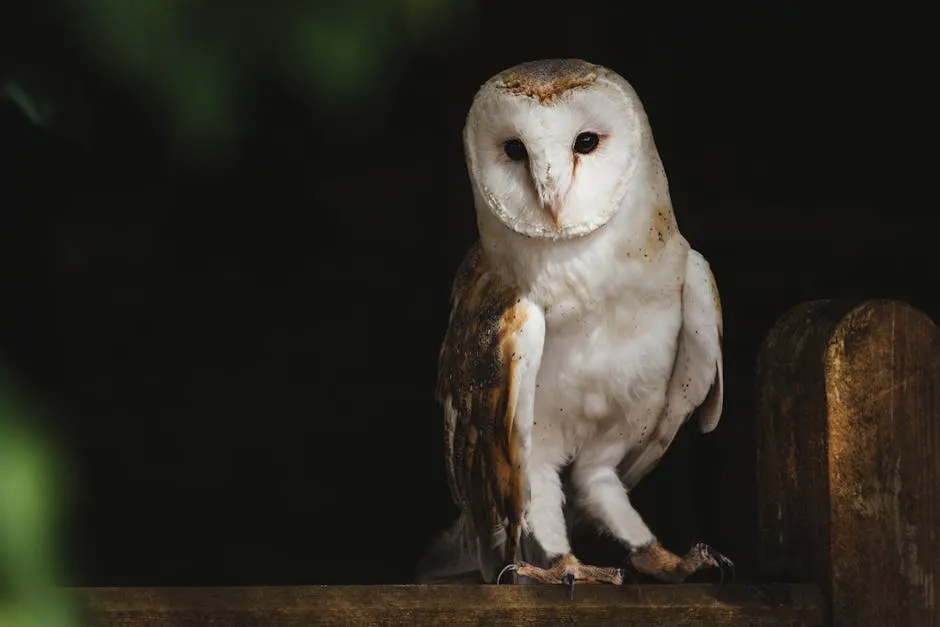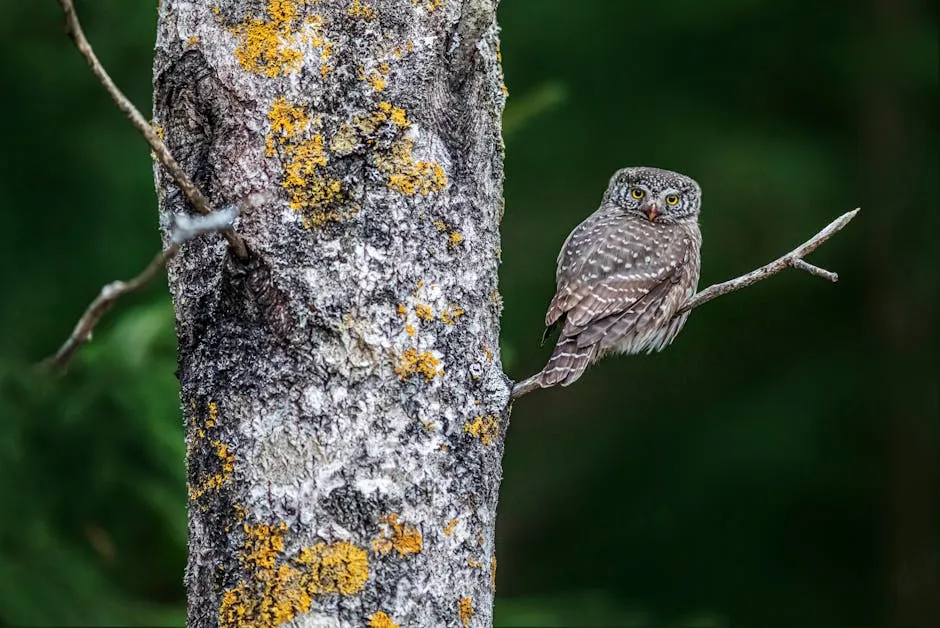
Why Do Owls Hoot?
Introduction
Have you ever been outside at night and heard the distinctive hoot of an owl? It’s a sound that evokes curiosity and wonder. Understanding how owls communicate is significant for appreciating their role in nature. This article explores the reasons behind owl hooting and what it means in their world.
To immerse yourself in the fascinating world of owls, check out the National Geographic Birds: A Visual Guide. This stunning book will have you identifying owls and other birds in no time!
Summary and Overview
Owls produce various sounds, but hooting is the most recognized. Common hooting species include the Great Horned Owl and the Barred Owl. Hooting plays a crucial role in territory marking, attracting mates, and ensuring survival. Culturally, owl hooting is often associated with mystery and wisdom, adding layers to its significance in human perception.

The cultural association of owls with wisdom adds depth to our understanding of their communication.
The Nature of Owl Vocalizations
Types of Sounds Owls Make
Owls communicate using a fascinating array of vocalizations. While hooting is well-known, they also screech, chirp, and produce other distinctive sounds. For instance, the Barn Owl emits a spine-chilling scream, while the Eastern Screech Owl makes a series of high-pitched whinnies.
Research shows that about 70 species of owls exist worldwide, but only a handful are known for hooting. Among these, the Great Horned Owl and the Barred Owl are the most prominent. In contrast, many smaller species may rely on softer, higher-pitched calls.
These vocalizations serve various purposes, from marking territory to signaling distress. Each sound has a specific role in the complex language of owls, showcasing their adaptability and communication skills. Owls are indeed vocal creatures, with calls serving as a vital aspect of their social interactions.
If you’re keen on observing these magnificent creatures, investing in quality Bird Watching Binoculars can enhance your experience. With crystal-clear optics, you can enjoy every detail of their fascinating behavior without disturbing them!
The Purpose of Hooting
Owls hoot for a few primary reasons, including marking territory and attracting mates. Hooting serves as a vocal declaration, signaling to other owls that a specific area is claimed. This communication helps establish boundaries, reducing conflicts with neighboring owls.
Additionally, hooting plays a vital role in mate attraction. During the mating season, owls use their calls to find partners. The distinct rhythms and pitches of their hoots help convey messages about their readiness to breed. For example, male Great Horned Owls typically produce deeper, resonant hoots, while females may respond with higher-pitched calls. This duet reinforces their bond and confirms their territory.
Different owl species exhibit unique hooting styles. The Barred Owl, famous for its iconic call, sounds like “Who cooks for you? Who cooks for you all?” In contrast, the Great Horned Owl has a series of low, booming hoots. These variations highlight the rich communication landscape among owls. Understanding these vocalizations allows us to appreciate how these fascinating creatures interact within their habitats.

Why Do Owls Hoot at Night?
Owls are primarily nocturnal, meaning they are most active during the night. This behavior aligns perfectly with their hooting. The cover of darkness provides an ideal setting for hunting and social interactions. Since owls rely heavily on their hearing and night vision, they thrive in low-light conditions.
Hooting is most common during specific times, especially right after sunset and just before sunrise. During these periods, owls announce their presence, establish territory, and attract mates. The stillness of night amplifies the sound, allowing it to travel far and wide.
Interestingly, owls may also hoot throughout the night, especially when defending their territory or communicating with mates. This nocturnal activity is crucial for their survival and reproduction. Understanding their behavior enriches our connection with nature and highlights the importance of these enigmatic birds in our ecosystem.

For those adventurous souls, a pair of Night Vision Goggles can make your nighttime explorations even more thrilling! Imagine spotting owls and other nocturnal wildlife in their natural habitat, all while staying stealthy!
Seasonal Patterns of Hooting
Owls exhibit fascinating seasonal behaviors, especially during the breeding period. As winter approaches, many species begin their courtship rituals. This is when you’ll notice an increase in hooting. Each hoot carries significant meaning, signaling readiness to mate and establish territory.
During the mating season, hooting becomes more intense and frequent. Males often compete with one another, showcasing their strength through vocalization. This display is essential for attracting potential partners and warning rivals. Female owls, too, respond with their own calls, creating a duet that reinforces their bond.
The timing of these vocalizations aligns with specific months. For instance, Great Horned Owls often start hooting as early as January. They prefer to begin early to ensure their young have ample food when spring arrives. This strategy helps them secure a successful breeding season, allowing their chicks to thrive as they learn to hunt.

These seasonal patterns highlight the importance of hooting in owl communication. Each call is not merely a sound; it’s a crucial part of their reproductive strategy and social behavior. Understanding these patterns enriches our appreciation of owls in their natural habitats.
The Significance of Hooting in Owl Communication
Territorial Claims
Hooting plays a vital role in establishing and defending territory among owls. This vocalization is often the first line of communication, signaling to others that a specific area is claimed. When an owl hoots, it announces its presence loudly and clearly, warning intruders to keep their distance.
During territorial disputes, the intensity and frequency of hooting can escalate. Owls may engage in “hoot-offs,” where they challenge one another through calls. This not only helps to assess rivals but also reduces physical confrontations. The more confident an owl sounds, the more likely it is to deter an intruder without resorting to violence.

Territorial claims are especially pronounced during the breeding season. Mated pairs will hoot in unison, marking their territory while reinforcing their bond. This collaboration ensures that both partners are aware of their boundaries, reducing the risk of conflict with neighboring owls. Ultimately, hooting serves as both a warning and a declaration, essential for survival in the wild.
Social Interactions and Pair Bonding
Owls are fascinating creatures, and their hooting plays a key role in their social interactions. One of the most important uses of hooting is during mating rituals. When owls mate, they establish strong pair bonds. This connection is often reinforced through vocal communication.
A notable behavior among mating pairs is the duet. Male and female owls often hoot in unison, creating a beautiful harmony. This duet not only showcases their bond but also helps to confirm their territory to other owls. The male usually starts the call, followed by the female’s response. This synchronized interaction fosters a sense of unity and strengthens their partnership.
In addition to bonding, these vocalizations serve practical purposes. They help owls communicate their presence to potential rivals. By hooting together, mated pairs signal that their territory is occupied, discouraging intruders. This behavior is essential for maintaining their relationship and ensuring the safety of their nesting area.

Overall, hooting is not just a sound; it’s an integral part of owl social life. Through their calls, owls engage in meaningful interactions that strengthen their relationships and protect their homes.
The Spiritual Meaning of Hooting
Hearing an owl hoot can feel like a mystical experience. In many cultures, owls symbolize wisdom and intuition. When you hear an owl’s call, it might be a reminder to trust your instincts. This connection often signifies guidance from the spiritual realm.
In dreams, owl calls can carry significant meanings. They may represent messages from your subconscious. If you dream of an owl hooting, it might suggest the need for self-reflection. Perhaps it’s time to let go of old habits and embrace change.
Many believe that owl hoots serve as warnings. They can alert us to be vigilant about our surroundings. This is especially true during times of uncertainty or major life shifts. The soothing yet eerie sound of an owl can help us tune into our inner selves.
Ultimately, the spiritual significance of owl hooting varies for everyone. It can symbolize transformation, protection, or guidance. Listening closely can help you uncover profound insights about your life and direction. So, the next time you hear that familiar hoot, pause and reflect. What is the owl trying to communicate to you?

Owls also symbolize protection, reminding us of their role in the ecosystem.
Conclusion
Understanding why owls hoot enriches our appreciation of these captivating birds. Their vocalizations serve vital purposes, from marking territory to attracting mates. For nature enthusiasts, recognizing owl communication can deepen your connection to wildlife.
If you’re eager to learn more or engage in a creative project, grab The Wisdom of Owls: A Coloring Book. It’s a fun way to relax and appreciate these beautiful creatures while unleashing your artistic side!
If you’re eager to learn more, consider exploring books or local birdwatching groups. Engaging with fellow owl lovers can enhance your experience. Share your thoughts and stories about owl hooting in the comments below!
And for those cozy nights, you might want to sip from an Owl-Themed Mug while reading about these fascinating creatures. Cheers to owls!
Please let us know what you think about our content by leaving a comment down below!
Thank you for reading till here 🙂
All images from Pexels




